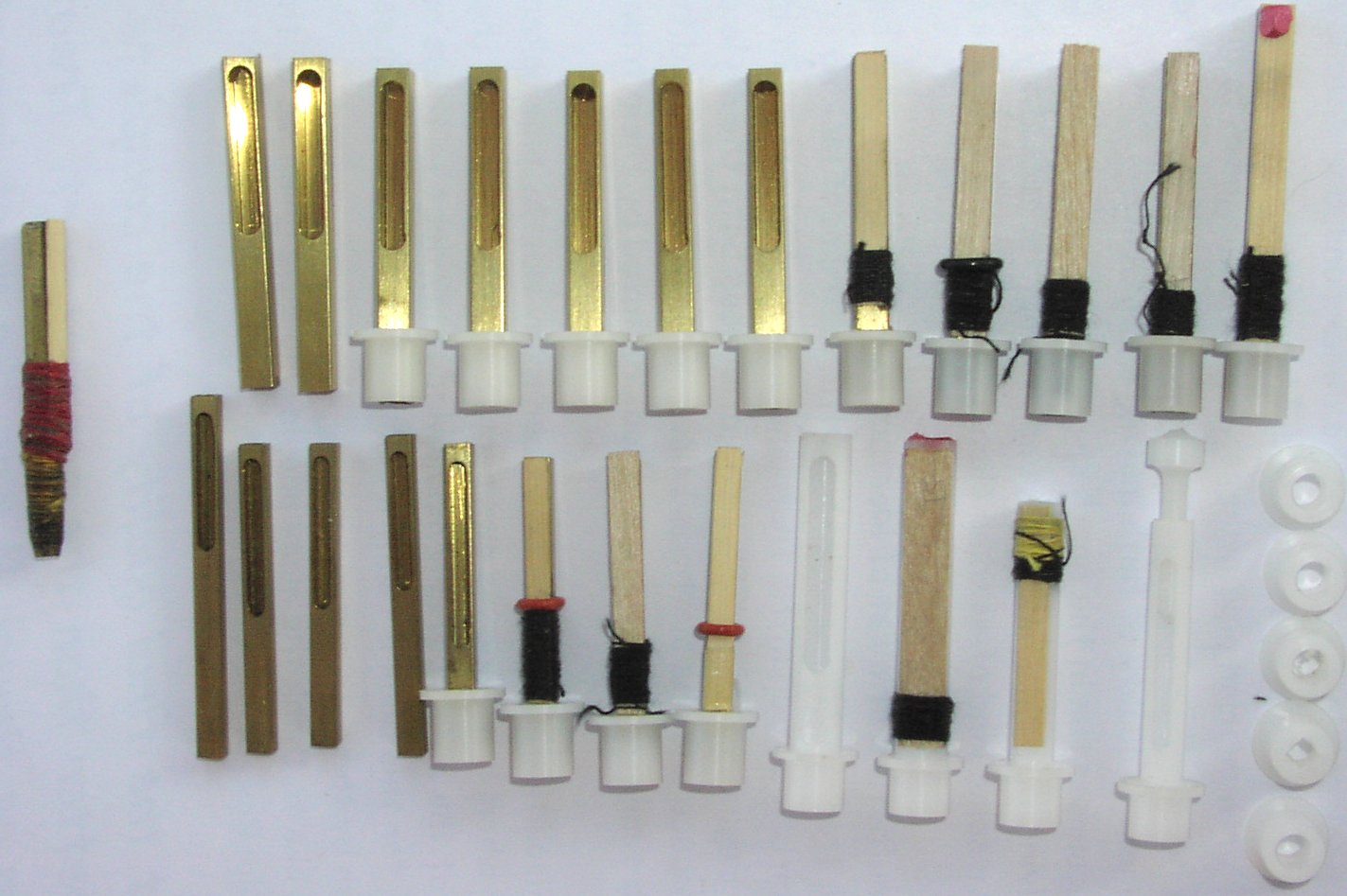
(updated 22/07/13) |

In the picture above are a number of the designs I tried. The ones made from square section brass tube were very successful. The opening was milled and the end of the tube blanked off with a square of balsa held in with super glue. The top hat bush was glued on and the gap between the round and the square filled with the glue. I tried a number of different ways to hold the tongue to the body and probably the best from a production point of view was a narrow (1/4") strip of sticky tape. I used a tape made by Scotch called "magic tape" that is used for mending torn drawings etc. and has a much better and more permanent glue than Sellotape. I also found that a small O ring was a good bridle and easy to move about.
I started by making the tongues from the same material that we use for chanter reeds but the preparation of it is a bit tedious and hard to replicate with any accuracy so I tried a thin (1/64") plywood that I use for aeromodeling and I was pleasantly surprised to find that it was every bit the equal tonally to the reed cane tongues and so much cheaper and easier to use.
One of the influences was the new modern designs of Highland pipe reeds. These are extremely reliable and easy to set up but much too big for the smallpipes so I looked to see if there was any of the features that could be used on smallpipe reeds.


I understand that the problem of fitting working reeds and keeping them working has proved a major obstacle to using the pipes in the teaching roll that they were designed for. The project has languished unloved and unwanted till today when a combination of enthusiasm from the new management of the Pipers Society, interest from Kathryn Tickell, my retirement from full time employment and some help from others in the NPS, we are once more trying to get things working. In 2011 I had 6 sets of un-made-up components to act as a prototype pool to develop the reeds especially the drone reeds. These sets were used for a trial session at the Cambridge Folk Festival and were very successful.
I was able to check the manufacturing quality for the first time and it was very poor. The company who did the machining (North East Assemblies) appears to have ignored the tolerances and in some cases even the dimensions. I have worked out a scheme for solving the manufacturing problems and I aim to have checked it out in the near future.
Early in 2012 I was issued with 10 sets from the "Working Pool" There were no working sets in this group. only 2 had chanter reeds and both were broken, 2 drones had reeds but they worked badly. I have now reworked all the mechanical problem with these sets and am in the process of setting them up with working reeds.
My experience with the ply tongues is that they require some hands on effort to keep them working - flicking the tongue open if it settles to a too closed state. This would be acceptable if the teachers using these sets had been able to do the reed tweaking but sadly this has not been the case. I have put considerable effort into creating G and d drone reeds that are completely reliable. My hope is that if a reed stops working for any reason then a replacement can be simply dropped in place in just a few seconds and will work without any intervention.
I have a design for the G drone that appears to be repeatable to make, reliable in use, very easy to play i.e. has a small pitch change to bag pressure ratio and sounds as good as a good cane reed. By adding a very small amount of weight to the tongue it appears that this same set of dimensions will work for the big D drone but I still have to do the development to prove that.
I have a design for the small d drone that looks very promising.
One extra change to the design has been to modify the interface to the drone by soft soldering a 1/8" o/d pipe to the main body and pushing the top hat interface piece onto that. By doing the fitting of the reed this way the same design will also fit the traditional set by just replacing the push on top hat with some waxed thread wrapping.
I have tested this on the G drone of a friends Nigel Barlow set that had dropped its traditional composite reed into the bag and the tongue was lost. I have also replaced the small d drone on the same set as the original reed was very unreliable and quite sensitive to pressure changes.
The Carbon fibre G & d drone reeds are the most stable that I have played and the pitch changes very little for a significant pressure change. This makes them very easy to play. The main feature of this reed design is that the reed body is bent rather than the tongue being curved. This has enabled the reed tongue to be moulded flat in carbon fibre thus giving a reliable action not affected by temperature, time, or humidity.
I have tried a few of the variables and have settled on a working set of dimensions that I am happy with (at present). Here are some to the options that I had to play with:-
I had the option of two thicknesses of Russian unidirectional carbon fibre cloth: 0.08 mm and 0.12 mm thick. I was lucky that I have a friend who uses this stuff for model aeroplane making so I was able to try some offcuts to see if we were in the ballpark. Only one of the layups worked sufficiently well for me to think that it was possible to use. This was a layup using 3 layers of the 0.12mm cloth having the top and bottom layers running across the tongue and the middle layer running along the tongue. I then persuaded my friend to do me a 4" square sheet of this layup and a similar sheet using the 0.08mm cloth.
The resulting sheets are 0.39mm and 0.28mm thick. There is some slight variation in thickness across the sheets but that doesn't seem to have caused any problems.
I used 4mm wide strips of the 0.39mm sheet for the G drone reeds and 3.2mm wide strips of the 0.28mm sheet for the small d drone reeds
As part of the experimentation I used one of the first good G reeds to explore the effect of drone length on the pitch. Because all the drone parts of the Schoolpipes are interchangable this was easy, if a little time consuming, to do. The results were interesting. I was able to achieve the same pitch with a number of different lengths which seems to indicate that the large diameter part of the bore that results from the tenon of the sliding part is having a significant effect on the pitch.
To see the results go here

|
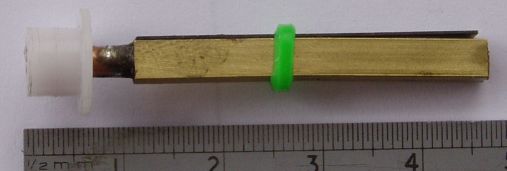
|
| Carbon Fibre G drone Reed Front | Carbon Fibre G drone Reed Side |
 |
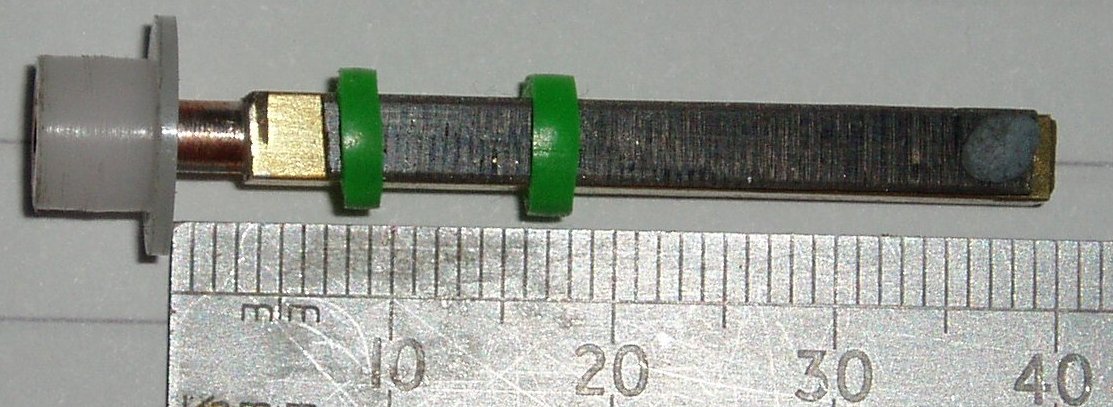 |
| Small d Carbon Drone Reed (the tongue hasn't been glued on yet and is held with the green silicon rubber rings as shown) | Large D Carbon Drone Reed note the bluetac tip weight |
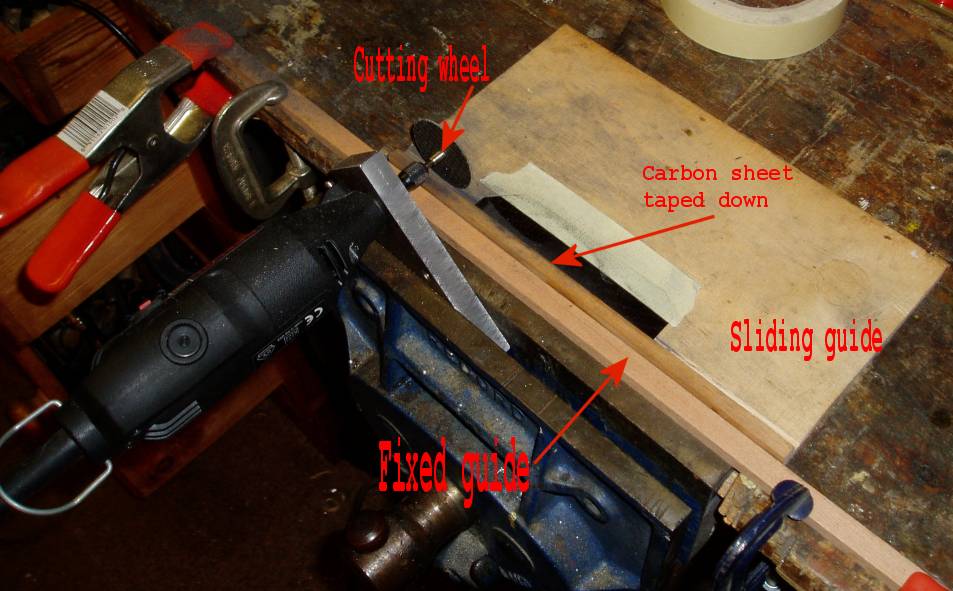
|
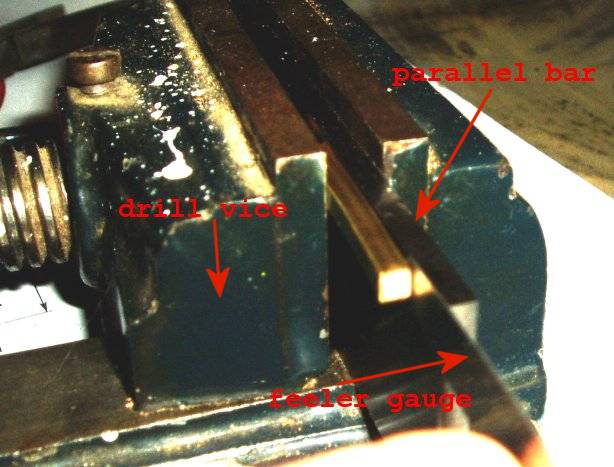 |
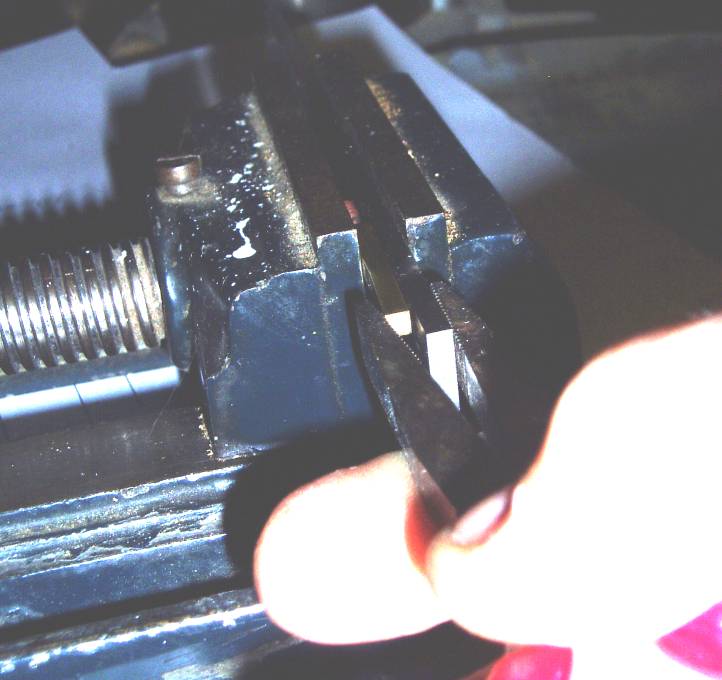
| 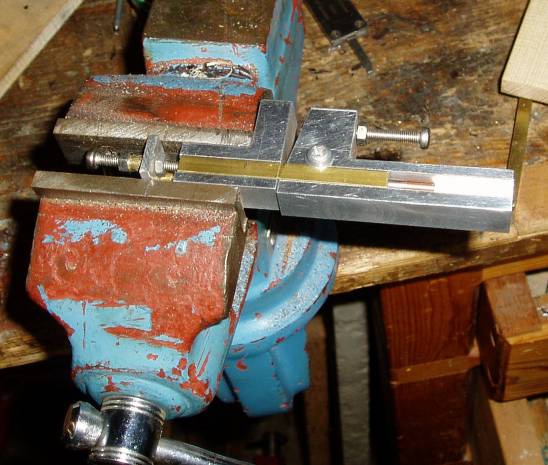
|
| Cutting the carbon fibre strips for the tongues | Measuring the actual gap at the tip of the reed | Adjusting the bend to give the required gap | Reed bending jig |

|
 |

|
| Slicing the bridles from silicon tube | Sliced bridles ready to be used | Close up of the G drone reed tip |
The testing of these reeds was done in my test rig as described above. The reeds and the tongues were as close to identical as I can manage. All the reeds were G reeds made to the drawings above and fitted with 4mm wide x 0.39mm thick carbon fibre tongues also as described above.
The testing was done in a concert G drone, made for use in the Schoolpipes, by adjusting the drone to play as close to concert G as possible when the pressure was 15"WG (15 inches water gauge). The pressure was then changed by 0.5"WG and a reading taken of the change in pitch. This was repeated for pressures above 15"WG up to 17.5"WG, the maximum the test rig provides) and down until the reed stopped sounding (or when I felt that any lower would add no value to the data). All this data was recorded and loaded into a spreadsheet to create the graphs.
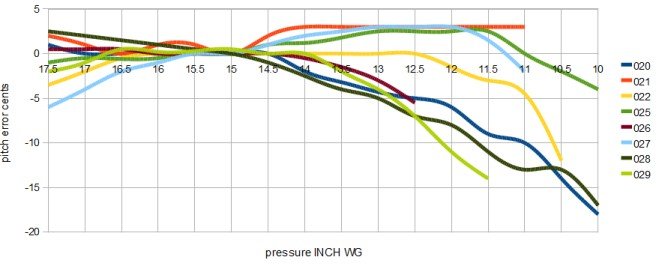
|
This set of reeds is from some that I made during my search for a really reliable reed for the Schoolpipe Project. I had noticed that the results I was getting were quite insensitive to pressure changes and this is shown in the graphs. This design has also proved totally reliable and continues to work without the need for any intervention. All of the reeds in this set were stable to better than 5cents for 2"WG pressure deviation. One of the reeds (021) is different to the rest and that reed has a narrower carbon blade (about 3.3 wide) compared to the 4mm wide blades of all the others. |
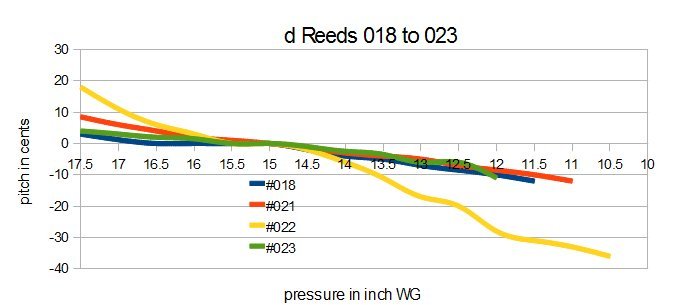
|
This set of reeds is also from some that I made during reed development for the Schoolpipe Project. This design has also proved totally reliable and continues to work without the need for any intervention. |
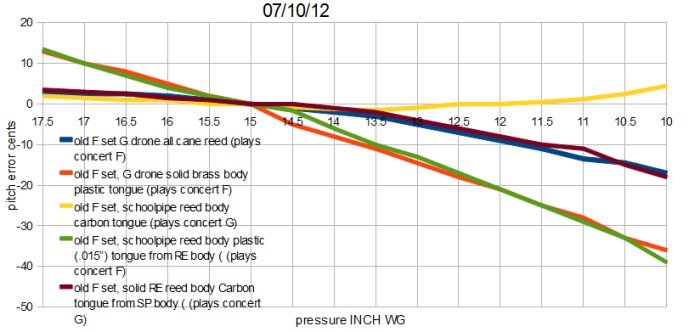
|
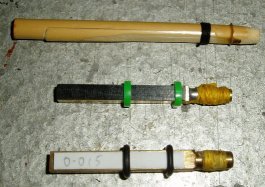 This is the set of reeds that the data was taken using. I also swaped the plastic and the carbon tongues to see what the effect was. The middle drone reed is a "new design" Schoolpipe G reed and the bottom reed is a machine body F reed from Richard Evans (a rather old one now). |
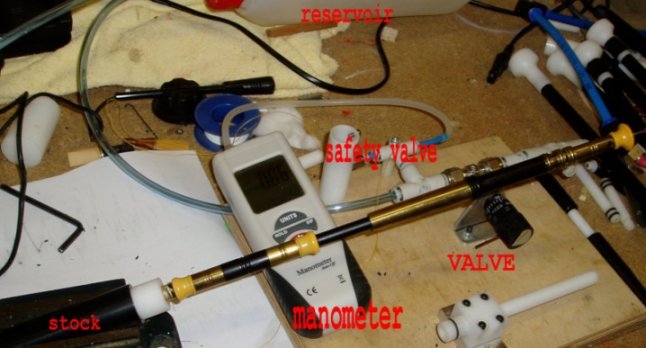
|
This is the test rig being used to get data from the traditional drone. The interface stock is held in a vice to give me 2 free hands to adjust the needle valve that controls the pressure and to write up the data. |
I have wondered for some time if the internal volume of a drone reed has any effect on the performance of the reed an what if any that effect is. I have now had a chance to make a prototype and test the result. I used a reverse design where the pivot of the reed blade is below the vibrating tip of the reed blade rather than above as in the traditional design. I had tried things this way round much earlier during my efforts to fine a good reliable reed design but this time I used a solid machined version based on the design by Richard Evans . This enabled me to tap out the internal bore of the reed body and, by using screws of different lengths, change the internal volume of the reed. The results showed that, although a small difference was measurable, the effect of reducing the internal volume was minimal. reducing the volume by 6mm (changing the 6mm long screw for a 12mm long screw) raised the pitch by 20 cents which was the same as moving the sliding part 2.5mm.

|
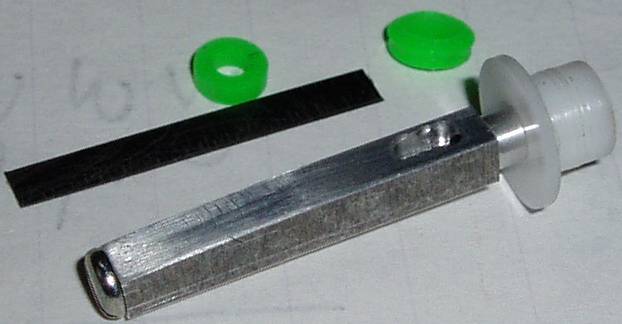
|

|
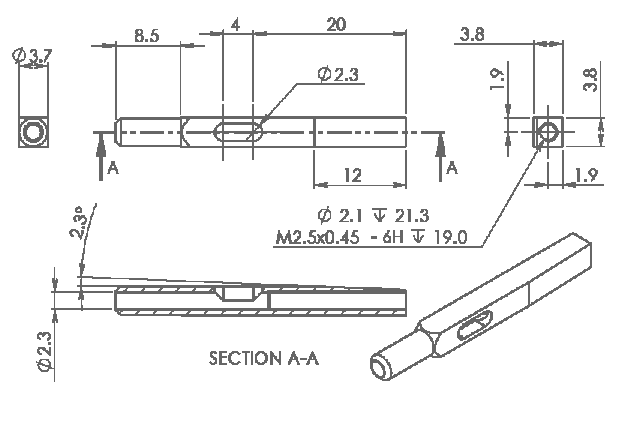
|
© 1997 Mike Nelson